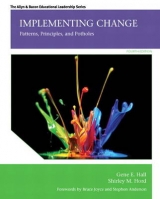
Implementing Change
Pearson (Verlag)
978-0-13-701027-1 (ISBN)
- Titel erscheint in neuer Auflage
- Artikel merken
Significantly revised based on student and instructor feedback, the new third edition of Implementing Change continues to examine the ways in which change processes are experienced by those "on the ground" while adding new features, new material and the most current research. Based primarily on the Concerns Based Adoption Model (CBAM), this user-friendly text focuses on introducing constructs that can be used by those engaged in facilitating change processes as well as those who are evaluating and studying change.
Rather than maintaining a bird’s eye view of change processes, each chapter introduces a research-based, research-verified construct about change that captures the complexity of implementing change and the diversity of reactions to it. With a stress on pedagogical aids, each chapter incorporates practical examples, sample research, case studies, reflection questions and examples of common roadblocks to change.
Gene Hall has over thirty years of experience studying the change process in schools, higher education, businesses, and governments. He has been a faculty member and administrator at four universities and is on the author team of Foundations of American Education (Allyn & Bacon, 2011), and The Joy of Teaching (Allyn & Bacon, 2008). He has conducted many studies of change processes, program evaluations and implementation assessments. He also serves regularly as a change process coach for leaders and aspiring leaders.
Preface
Foreword by Stephanie Hirsch
Dedication
Part I The Context for Implementing Change
Chapter 1 Implementing Change: Patterns, Principles and Lessons Learned
WHY A BOOK ON “IMPLEMENTING CHANGE?”
Focus Questions
Principles of Change
Change Principle 1: Change Is Learning–It’s as Simple and Complicated as That
Change Principle 2: Change is a Process, Not an Event
Change Principle 3: The School is the Primary Unit for Change
Change Principle 4: Organizations Adopt Change–Individuals Implement Change
Change Principle 5: Interventions Are the Key to the Success of the Change Process
Change Principle 6: Appropriate Interventions Reduce Resistance to Change
Change Principle 7: Administrator Leadership Is Essential to Long-Term Change Success
Change Principle 8: Facilitating Change Is a Team Effort
Change Principle 9: Mandates Can Work
Change Principle 10: The Context Influences the Process of Learning and Change
Summary DISCUSSION QUESTIONS
FIELDWORK ACTIVITIES
CONDUCT A STUDY
ADDITIONAL READINGS/RESOURCES
Chapter 2 Developing Professional Learning Communities: A Powerful Context for Change
Focus Questions
ORIGINS OF ORGANIZATIONAL CULTURE AND PROFESSIONAL LEARNING COMMUNITY
Five Disciplines
Seventeen Factors
The PLC Context and Culture
Dimensions of a Professional Learning Community Shared Values and Vision
Intentional Learning and Application
Supportive and Shared Leadership
Supportive Conditions
Physical Conditions
People Capacities
Shared Personal Practice
Structure of the PLC Dimensions
Who Is the Professional Learning Community?
Benefits of a Professional Learning CommunitySchools
Leadership Teams
University Schools
Leadership AND INTERACTION in a Professional Learning Community
Collegial Learning
Sharing Responsibilities
Using Conversations
Types of Leadership
Other Leadership Ideas to Be Considered
Strategies for Facilitating a PROFESSIONAL LEARNING Culture
Our Closing Pitch
Summary DISCUSSION QUESTIONS
FIELDWORK ACTIVITIES
CONDUCT A STUDY
ADDITIONAL READINGS/RESOURCES
Assessment Instrument
Recent Books
Part II Tools and Techniques for Understanding Implementation at the Individual Level
Chapter 3
Clarifying the Change: Innovation Configurations
Focus Questions
The Change: What it is and is Not
Innovation Adaptation
Innovation Configurations as a Concept
Mapping Innovation Configurations
Innovation Configuration Maps
IC Map Components
Developing Clear Word-Picture Descriptions
Indicating Ranges of Quality and Fidelit
Student Roles in IC Maps
Other Roles in IC Maps
More Complex and Richer IC Map Components
The Process of Developing an IC Map IC Map Components
Innovation Configurations: Applications and Implications
Using IC Maps to Facilitate Change
Using IC Maps in Research, Evaluation, and Implementation Assessments
The Fidelity Enigma
Summary
DISCUSSION QUESTIONS
FIELDWORK ACTIVITIES
CONDUCT A STUDY
ADDITIONAL READINGS/RESOURCES
CHAPTER 4 Understanding Feelings and Perceptions about Change: Stages of Concern (SoC)
Focus Questions
The Personal Side of Change
Different Types of Concerns have been Identified
Fuller’s Unrelated, Self, Task, and Impact Concerns
Connecting Concerns to Teacher Education
Concerns and the Change Process
Identifying the Stages of Concern
Why Are They Called “Stages” of Concern?
Can There Be Concerns at More than One Stage?
Are There Typical Concern Profiles?
Techniques for Assessing Stages of Concern
The One-Legged Interview (OLI)
The Open-Ended Statement
The Stages of Concern Questionnaire
Change Facilitator SoCQ
Characteristic Stages of Concern Profiles
The “Big W” Concerns Profile
Implications of Resistance in Stages of Concern Profiles
SUMMARY
Discussion Questions
Fieldwork Activities
Conduct a Study
Additional Readings
Chapter 5 Exploring the Use of Innovations: Levels of Use
Focus Questions
The Levels of Use Concept
Nonusers
Level of Use 0 Nonuse Level of Use I Orientation
Level of Use II Preparation
Level of Use 0 Nonuse
Level of Use III Mechanical Level of Use IVA Routine
Level of Use IVB Refinement
Level of Use V Integration
Level of Use VI Renewal
Level of Use
Assessing an Individual’s Level of Use
The LoU Branching Interview
The LoU Focused Interview Knowledge
Acquiring Information
Sharing
Assessing
Planning
Status Reporting
Performing
Applying Levels of Use
Facilitation of Change
Motivation for Movement in LoU
Evaluation of Change
Sidelights about LoU
Summary
DISCUSSION QUESTIONS
FIELDWORK ACTIVITIES
CONDUCT A STUDY
ADDITIONAL READINGS/RESOURCES
Part III The Imperative for Leadership in Change
Chapter 6 Defining leaders and the Differences They make: Change Facilitator Style
Focus Questions
The History of Research on Leaders and Leadership
The Legacy of Research on Leadership
Discovering in an Implementation Study that School Leaders were making a Difference
Implementation Data that were a Mystery
What would explain the differences?
Principal Leadership is the Key
The Concept of Change Facilitator Style
Three Change Facilitator Styles
Initiator Change Facilitators
Manager Change Facilitators
Responder Change Facilitators
Discussion and Implications of Change Facilitator Style
A Continuum of Change Facilitator Styles
Metaphors for Change Facilitator Styles
Additional Research and Support for Change Facilitator Styles
Research Findings: Intervention Behaviors of each CF Style Principal
Research Findings: Relating Change Facilitator Style to Teacher Success in Implementing Innovations
Research Findings: Relationships of Principal CF Style to Student Learning
Underlying Dimensions and Measurement of Change Facilitator Style
Six Dimensions of Change Facilitator Style
Concern for People
Social/Informal
Formal Meaningful
Organizational Efficiency
Trust in Others
Administrative Efficiency
Strategic Sense
Day-to-Day
Vision and Planning
Measuring Change Facilitator Style with the CFSQ
IDEAS, IMPLICATIONS AND REFLECTIONS ABOUT CHANGE FACILITATOR
Change Facilitator Style as a Heuristic
Working with Different Change Facilitator Styles
Working with Initiators
Working with Responders
Working with Managers
Summary
Discussion Questions
Fieldwork Activities
Conduct a Study
Chapter 7 Describing What Change Facilitators Do: Interventions Focus Questions
Intervention Definition
Intervention Delivery
Six Functions of Interventions
Function I: Developing, Articulating, and Communicating a Shared Vision of the Intended Change
Function II: Planning and Providing Resources
Function III: Investing in Professional Learning
Function IV: Checking on Progress
Function V: Providing Continuous Assistance
Function VI: Creating a Context Supportive of Change
Additional Kinds of Interventions
Communicating Externally
Disseminating Information
Sizes of Interventions
Policies
Game Plan Components
Strategies
Tactics
Incidents
Isolated Incident
Simple Incident
Chain Incident
Repeated Incident
Complex Incident Isolated Incident
The Anatomy of Interventions
Source
Target
Function
Summary 203
DISCUSSION QUESTIONS
FIELDWORK ACTIVITIES
CONDUCT A STUDY
Additional READINGS/RESOURCES
Chapter 8 The construction of Understanding: Intervention Mushrooms
Focus Questions
Introducing Mushrooms: A Unique Form of Intervention
Two Ways of Knowing: Objectivist and Interpretivist
The Objectivist Perspective of Change
The Interpretivist Perspective of Change
Intervention Mushrooms Are Constructed
Recognizing the Theme of a Mushroom
The Life Cycle of Intervention Mushrooms
The Birth of a Mushroom
The Growth of a Mushroom
The Maturing of a Mushroom
Keys to the Construction of Intervention Mushrooms
Stages of Concern as a Source of Mushrooms
Personal Concerns: A Significant Source of Negative Mushrooms
Intervening on Insecurity Mushrooms
Impact Concerns: A Significant Source of Positive Mushrooms
Levels of Use as a Rubric for Developing Understanding of Mushrooms
Levels of Use from a Constructivist Perspective
LoU-Based Mushrooms
Change Facilitator Style and Mushrooms
Different Change Facilitator Styles Have Different Meanings
Initiator CF Style: The meaning within a question
Manager CF Style: The Meaning within a Question
Responder CF Style: The Meaning within a Question
Keys to Detecting Mushrooms Positive Mushroom Growth can be Encouraged
Intervening on Positive Mushrooms
Mushroom Detection by Change Facilitator Style
Initiator CF Style Leaders are Early Detectors
Responder CF Style: Respond to Some of the Individual Actions
Manager CF Style: Keep Things Evened Out
Evergreen Mushrooms
Sometimes Doing Nothing is Best
Summary
Discussion Questions
Fieldwork Activities
Conduct a Study
Additional Readings
Part IV Different Perspectives for Understanding the Big Picture of Change
CHAPTER 9 Systems Thinking: Interconnections of Parts That Make a Whole
Focus Questions
Familiar Names in Systems Thinking
Going Deeper to Examine a Systems View
Components of the Educational System
Components of Systems in Change
Characteristics of Systemic Policy
Elements of Systemic Reform
Working Systemically in Schools
Components
Levels
Competencies
The Cube
Competencies from Other Writers
Effects of Working Systemically
Outcomes for Educators
Results for Students
Facilitators and Barriers to Working Systemically
Facilitators of the Change
Barriers to the Change Process
Limitations of Working Systemically
Summary
DISC
DISCUSSION QUESTIONS
FIELDWORK ACTIVITIES
CONDUCT A STUDY
Additional READINGS/RESOURCES
Chapter 10 Diffusion
Communication and Change Agents
Focus Questions
Communication
Within the Lines and Networks?
Components of Interpersonal Communication
Understanding Communication Networks
Implications of Communication Networks for Facilitating Change
Communication of Innovations: Who is Doing What?
Communication Elements: Sources, Targets, and Media
Sources of Communication
Targets of Communication
Media in Communication
Purpose of Communication
Coding Communication Actions in General
Implications of Coding Communications for Facilitating Change
Characteristics of Adopters
Five Adopter Categories
Innovators are Excited About Trying Something New
Early Adopters Think before Adopting
Early Majority are Careful
Late Majority are Cautious
Laggards Resist the New
There is a predictable Pattern to the flow of information across adopter categories
Opinion Leaders
Communicating across Adopter Categories
There is a Predictable Pattern to the Rate of Innovation Adoptions
The S Curve Explains it all
Critical Mass Signifies an Important Point
Implications of Adopter Categories for Facilitating Change
Other Diffusion Constructs: Perceptions of the Innovation and Characteristics of Change Agents
Perceived Attributes of the Innovation
Relative Advantage
Compatibilty
Complexity
Trialability
Observability
Addressing Perceived Attributes of the Innovation
The Role of Change Agents
Summary
Discussion Questions
Fieldwork Activities
Conduct a Study
Chapter 11 Organization Development Team Building, Action Research and Process Consultants
Focus Questions
What Is OD?
OD Definitions across the Decades
Training and Planning
Changing OD Definitions
OD Intervention Tools and Techniques
Survey Feedback
Exercises
Building Consensus
Team Functioning
OD Exercises are Job Context Free
Finding and Sharing OD Exercises
Team/group and Individual Process Skills
Team Decision Making
Brainstorming
Developing Consensus
Problem Solving
Force-Field Analysis
Meeting Skills
Individual Team Member Process Skills
Using OD to Change Whole Organizations
Assessing and Developing Climate/Culture
Organizational Climate Defined
Climate versus Culture
Interviewing to Assess Organization Culture
Examples of Organization Culture
Comparing Measurement of Climate and Culture
Strategic Planning
Making Strategic Planning Real
Providing Indicators/Evidence is Important
Action Research
OD Process Consultants
OD Consultants at Work
Planned Change Steps
OD Consultant Issues
Summary
Discussion Questions
Fieldwork Activities
Conduct a Study
Additional Reaings
Part V Combining Views and Tools
Chapter 12 Implementing Change: Assessing and Facilitating the Process from Individuals to Whole Systems
Focus Questions
Units of change range from the very large to the very small
The System as the Unit of Change
An Organization as the Unit of Change
Teams or Divisions as the Unit of Change
The Individual as the Unit of Change
The Change Perspective of the Concerns Based Adoption Model (CBAM)
CBAM Addresses the Individual
CBAM Addresses Teams and Groups
SoC Whole Group Profiles: Lap Top Computers for Teachers
SoC Subgroup Profiles
The Implementation Bridge: Using LoU and IC to Assess Change Progress
A School District Superintendent Wants to Know
Assessing Implementation
Action Research Can Happen
Two Snap Shots are Better than One
LoU is One Indicator
Another Indicator: Innovation Configurations
Fidelity of Implementation
Fidelity of Implementation of a Mathematics Innovation
The Bottom Line Question: What is the relationship between Extent of Implementation and Outcomes?
Which Research Design is Best?
Problems with Treatment-Control Group Designs
Comparing Degrees of Implementation
Leadership is a Very Important Factor
Relationships between CF Style and Student Outcomes
Principal CF Style and Student Test Scores
A Summary Systemic Framework
Principal CF Style and School Organization Culture
Final Reflections about Implementing Change
Ethical Issues in Facilitating Change
Understanding the Constructs
Responsible Use
Support at All Levels of the Organization
What about the Ethics of Change Agentry?
Ethical Behavior From a Concerns-Based Perspective
Wrong Interventions
Deliberate Manipulation
Continue Asking the Ethics Question
Summary
Discussion Questions
Fieldwork Activities
Conduct a Study
Additional ReaDings
Appendices
Appendix 1 Stages of Concern Questionnaire (Form 075)
Appendix 2 SoCQ Scoring Devise
Appendix 3 Levels of Use of the Innovation (operational definitions)
Appendix 4 Six Dimensions of Change Facilitator Style
Appendix 5 Change Facilitator Style Questionnaire (CFSQ)
Appendix 6 Change Facilitator Style Scoring Devise
| Erscheint lt. Verlag | 1.7.2010 |
|---|---|
| Sprache | englisch |
| Maße | 181 x 230 mm |
| Gewicht | 480 g |
| Themenwelt | Sozialwissenschaften ► Pädagogik |
| ISBN-10 | 0-13-701027-3 / 0137010273 |
| ISBN-13 | 978-0-13-701027-1 / 9780137010271 |
| Zustand | Neuware |
| Haben Sie eine Frage zum Produkt? |
aus dem Bereich



